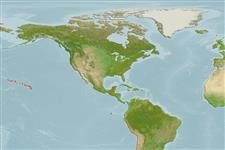>
Ovalentaria/misc (Various families in series Ovalentaria) >
Pomacentridae (Damselfishes) > Chrominae
Etymology: Dascyllus: Greek, daskillys, -on = a kind of fish (Ref. 45335).
More on author: Gill.
Environment: milieu / climate zone / depth range / distribution range
Ecologia
marinhas associadas(os) a recifes; não migratória; intervalo de profundidade 1 - 50 m (Ref. 7247). Tropical; 30°N - 15°N
Eastern Central Pacific: Hawaiian Islands and Johnston Island.
Tamanho / Peso / Idade
Maturity: Lm ? range ? - ? cm
Max length : 13.0 cm TL macho/indeterminado; (Ref. 9710)
Descrição suscinta
Chaves de identificação | Morfologia | Morfometria
Espinhos dorsais (total) : 12; Raios dorsais (total) : 15 - 16; Espinhos anais: 2; Raios anais : 15 - 16. Closely related D. trimaculatus, which does not occur in the Hawaiian Islands and Johnston Island.
Adults are found in very shallow, protected water, over coral and rocky bottoms. Young often sheltering among the branches of Pocillopora; occasionally commensal with the anemone Marcanthia cookei (Ref. 9710). Benthopelagic (Ref. 58302). Peak spawning from May to August. Age-at-maturity estimated at one year. Feed on zooplankton, benthic invertebrates, and algae (Ref. 9710). Oviparous, distinct pairing during breeding (Ref. 205). Eggs are demersal and adhere to the substrate (Ref. 205). Males guard and aerate the eggs (Ref. 205). Have been reared in captivity (Ref. 35412).
Ciclo de vida ou comportamento de acasalamento
Maturidade | Reprodução | Desova | Ovos | Fecundidade | Larvas
Oviparous, distinct pairing during breeding (Ref. 205). Eggs are demersal and adhere to the substrate (Ref. 205). Males guard and aerate the eggs (Ref. 205). While protogyny was originally proposed for this species, recent studies confirmed gonochorism in the form of non-functional hermaphroditism (Ref. 103751).
Allen, G.R., 1991. Damselfishes of the world. Mergus Publishers, Melle, Germany. 271 p. (Ref. 7247)
Status na Lista Vermelha da UICN (Ref. 130435: Version 2024-2)
Ameaça para os humanos
Harmless
Uso pelos humanos
Pescarias: espécies comerciais; Aquário: Espécies comerciais
Ferramentas
Relatórios especiais
Baixar XML
Fontes da internet
Estimates based on models
Preferred temperature (Ref.
123201): 24.2 - 25.9, mean 25.1 °C (based on 57 cells).
Índice de diversidade filogenética (Ref.
82804): PD
50 = 0.5005 [Uniqueness, from 0.5 = low to 2.0 = high].
Bayesian length-weight: a=0.02089 (0.00944 - 0.04623), b=2.98 (2.80 - 3.16), in cm total length, based on LWR estimates for this (Sub)family-body shape (Ref.
93245).
Nível Trófico (Ref.
69278): 3.1 ±0.3 se; based on diet studies.
Resiliência (Ref.
120179): Elevada, tempo mínimo de duplicação da população menor que 15 meses (Preliminary K or Fecundity.).
Fishing Vulnerability (Ref.
59153): Low vulnerability (10 of 100).
Nutrients (Ref.
124155): Calcium = 131 [68, 222] mg/100g; Iron = 1.15 [0.65, 1.98] mg/100g; Protein = 18.3 [17.0, 19.5] %; Omega3 = 0.119 [0.065, 0.219] g/100g; Selenium = 40 [19, 83] μg/100g; VitaminA = 62.9 [18.1, 229.5] μg/100g; Zinc = 1.67 [1.07, 2.47] mg/100g (wet weight);
